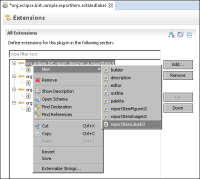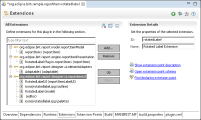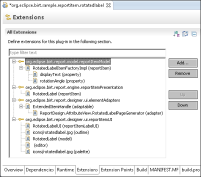Creating the plug-in extension content
The XML schema specifies a grammar that you must follow when creating an extension in the Eclipse PDE. When you select an element of an extension in the Extensions page of the PDE, Eclipse uses the XML schema to populate the Extension Element Details section with the list of valid attributes and values for the element.
How to specify the plug-in extension content
1 On PDE Manifest Editor, choose Extensions.
2 In All Extensions, right-click org.eclipse.birt.report.designer.ui.reportItemUI and choose New
➛reportItemLabelUI, as shown in
Figure 18‑7.
Figure 18‑7 Selecting a report item extension element
All Extensions adds the extension, org.eclipse.birt.sample.reportitem.rotatedlabel.ReportItemLabelUI (rotatedItemLabelUI), and Extension Element Details lists rotatedItemLabelUI properties.
3 In Extension Element Details, type the following fully qualified class name:
org.eclipse.birt.sample.reportitem.rotatedlabel.RotatedLabelUI
4 In All Extensions, right-click org.eclipse.birt.report.designer.ui.reportitemUI again and repeatedly choose New
➛<extension element> to add the following extension elements, properties, and values, as shown in
Table 18‑4. Note that PDE Manifest Editor creates the extension element rotated label model when adding this extension point. Change the default model value.
Table 18‑4 Properties for other reportitemUI extension elements
Extension element | Property | Value |
model | extensionName | RotatedLabel |
outline | icon | icons/rotatedlabel.jpg |
editor | showInMasterPage | true |
| showInDesigner | true |
| canResize | true |
| menuLabel | |
palette | icon | icons/rotatedlabel.jpg |
| category | |
| categoryDisplayName | |
Do not enter a property value in Extension Element Details if the value field for the property in the table is empty. Extension elements appear as shown in
Figure 18‑8.
Figure 18‑8 Specifying properties for rotatedItemLabelUI
5 In All Extensions, add the org.eclipse.birt.report.model.reportItemModel extension point. Select reportItem. In Extension Element Details, add the reportItem properties shown in
Table 18‑5.
Table 18‑5 Property values for reportItem
Extension element | Property | Value |
reportItem | extensionName | RotatedLabel |
| class | org.eclipse.birt.sample.reportitem.rotatedlabel.RotatedLabelItemFactoryImpl |
| defaultStyle | |
| isNameRequired | false |
| displayNameID | |
| extendsFrom | ExtendedItem |
| hasStyle | true |
| themeType | |
6 In All Extensions, in org.eclipse.birt.report.model.reportItemModel, perform the following tasks:
1 Right-click reportItem again and choose New
➛property to create a new extension element property with the settings shown in
Table 18‑6. The displayText property contains the text that the rotated label displays.
Table 18‑6 Property values for displayText
Extension element | Property | Value |
property | name | displayText |
| type | string |
| displayNameID | |
| detailType | |
| subType | |
| canInherit | true |
| defaultValue | RotatedLabel |
| isEncryptable | false |
| defaultDisplayName | Display Text |
| isList | false |
| hasOwnModel | true |
| allowExpression | |
2 Right-click reportItem and choose New
➛property to add an extension element property named rotationAngle. The settings for this property are shown in
Table 18‑7. As the property name suggests, this property contains the rotation angle of the displayed text.
Table 18‑7 Property values for rotationAngle
Extension element | Property | Value |
property | name | rotationAngle |
| type | string |
| displayNameID | |
| detailType | |
| subType | |
| canInherit | true |
| defaultValue | -45 |
| isEncryptable | false |
| defaultDisplayName | Rotation Angle |
| isList | false |
| hasOwnModel | true |
| allowExpression | |
7 In All Extensions, expand org.eclipse.birt.report.engine.reportitemPresentation and choose org.eclipse.birt.sample.reportitem.rotatedlabel.reportItem1(reportItem).
8 In Extension Element Details, modify the reportItem properties to the values shown in
Table 18‑8.
Table 18‑8 Property values for reportItem
Extension element | Property | Value |
reportItem | name | RotatedLabel |
| class | org.eclipse.birt.sample.reportitem.rotatedlabel.RotatedLabelPresentationImpl |
| supportedFormats | |
9 In All Extensions, right-click org.eclipse.birt.report.designer.ui.elementAdapters and choose org.eclipse.birt.sample.reportitem.rotatedlabel.Adaptable1(adaptable).
10 In Extension Element Details, modify the adaptable property to the following class:
org.eclipse.birt.report.model.api.ExtendedItemHandle
11 In All Extensions, right-click ExtendedItemHandle (adaptable) and choose New➛adapter.
12 In Extension Element Details, add the adapter properties shown in
Table 18‑9.
Table 18‑9 Property values for the adapter
Extension element | Property | Value |
adapter | id | ReportDesign.AttributeView.RotatedLabelPageGenerator |
| type | org.eclipse.birt.report.designer.ui.views.IPageGenerator |
| class | |
| factory | org.eclipse.birt.sample.reportitem.rotatedlabel.views.RotatedLabelPageGeneratorFactory |
| singleton | false |
| priority | 1 |
| overwrite | |
| comments | |
Figure 18‑9 shows the full list of extension points and elements required for the example, org.eclipse.birt.sample.reportitem.rotatedlabel.
Figure 18‑9 Viewing extension points for the rotated label report item



